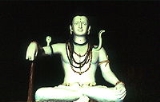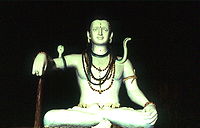
Thirumandhiram
Encyclopedia

Tamil language
Tamil is a Dravidian language spoken predominantly by Tamil people of the Indian subcontinent. It has official status in the Indian state of Tamil Nadu and in the Indian union territory of Pondicherry. Tamil is also an official language of Sri Lanka and Singapore...
poetic work written in the 5th CE by Tirumular and is the tenth of the twelve volumes of the Tirumurai, the key texts of Tamil Saivism. It is the first known Tamil work to use the term Shaiva Siddhanta
Shaiva Siddhanta
Considered normative tantric Saivism, Shaiva Siddhanta provides the normative rites, cosmology and theological categories of tantric Saivism. Being a dualistic philosophy, the goal of Shaiva Siddhanta is to become an ontologically distinct Shiva . This tradition was once practiced all over India...
and the earliest known exposition of the Saiva Agamas
Āgama (Hinduism)
Agama means, in the Hindu context, "a traditional doctrine, or system which commands faith".In Hinduism, the Agamas are a collection of Sanskrit scriptures which are revered and followed by millions of Hindus.-Significance:...
in Tamil
Tamil language
Tamil is a Dravidian language spoken predominantly by Tamil people of the Indian subcontinent. It has official status in the Indian state of Tamil Nadu and in the Indian union territory of Pondicherry. Tamil is also an official language of Sri Lanka and Singapore...
. It consists of over three thousand verses dealing with various aspects of spirituality, ethics and praise of the God Shiva
Shiva
Shiva is a major Hindu deity, and is the destroyer god or transformer among the Trimurti, the Hindu Trinity of the primary aspects of the divine. God Shiva is a yogi who has notice of everything that happens in the world and is the main aspect of life. Yet one with great power lives a life of a...
. But it is more spiritual than religious and one can see the difference between Vedanta and Siddhanta from Tirumular's interpretation of the Mahakaavyas. According to historian Venkatraman, the work covers almost every feature of the Tamil
Tamil people
Tamil people , also called Tamils or Tamilians, are an ethnic group native to Tamil Nadu, India and the north-eastern region of Sri Lanka. Historic and post 15th century emigrant communities are also found across the world, notably Malaysia, Singapore, Mauritius, South Africa, Australia, Canada,...
siddha cult. According to another historian Madhavan, the work stresses on the fundamentals of Siddha medicine and its healing powers. It deals with a wide array of subjects including astronomy, physical culture, etc.
Analysis
In short, the Tirumandiram, strongly emphasizes on Love is God, (Anbey Sivam).The Tirumantiram is divided into nine chapters (tantirams);
- 1. Philosophical views and divine experience, impermanency of the physical body, love, education etc.
- 2. Shiva's glory, His divine acts, classification of souls etc.
- 3. YogaYogaYoga is a physical, mental, and spiritual discipline, originating in ancient India. The goal of yoga, or of the person practicing yoga, is the attainment of a state of perfect spiritual insight and tranquility while meditating on Supersoul...
practices according to the eight-angled way of Patanjali.
- 4. MantraMantraA mantra is a sound, syllable, word, or group of words that is considered capable of "creating transformation"...
, tantraTantraTantra , anglicised tantricism or tantrism or tantram, is the name scholars give to an inter-religious spiritual movement that arose in medieval India, expressed in scriptures ....
, etc.
- 5. Various branches of Saiva religion; the four elements of Shaiva SiddhantaShaiva SiddhantaConsidered normative tantric Saivism, Shaiva Siddhanta provides the normative rites, cosmology and theological categories of tantric Saivism. Being a dualistic philosophy, the goal of Shaiva Siddhanta is to become an ontologically distinct Shiva . This tradition was once practiced all over India...
.
- 6. Shiva as guru bestowing grace and the devotee's responsibility.
- 7. Shiva linga, Shiva worship, self-control.
- 8. The stages of soul experience .
- 9. Panchadsara manthiram, Shiva's dance, the state of samadhi, etc.
The poems have a unique metrical structure, each line consisting of 11 or 12 syllables depending on the initial syllable. Tirumular discusses the four steps of spiritual progress; Charya, Kriya
Kriya
Kriya most commonly refers to a "completed action", technique or practice within a yoga discipline meant to achieve a specific result. Types of kriya may vary widely between different schools of yoga. Another meaning of Kriya is the outward physical manifestations of awakened kundalini...
, Yoga
Yoga
Yoga is a physical, mental, and spiritual discipline, originating in ancient India. The goal of yoga, or of the person practicing yoga, is the attainment of a state of perfect spiritual insight and tranquility while meditating on Supersoul...
and Gnana, the Shaiva Siddhanta
Shaiva Siddhanta
Considered normative tantric Saivism, Shaiva Siddhanta provides the normative rites, cosmology and theological categories of tantric Saivism. Being a dualistic philosophy, the goal of Shaiva Siddhanta is to become an ontologically distinct Shiva . This tradition was once practiced all over India...
concept of Pati, Pasu and Pasa where Pati stands for Lord shiva, Pasu stands for the human kind and Pasa stands for Maya (the desire) , sadhana, Vedanta
Vedanta
Vedānta was originally a word used in Hindu philosophy as a synonym for that part of the Veda texts known also as the Upanishads. The name is a morphophonological form of Veda-anta = "Veda-end" = "the appendix to the Vedic hymns." It is also speculated that "Vedānta" means "the purpose or goal...
, the Upanishad
Upanishad
The Upanishads are philosophical texts considered to be an early source of Hindu religion. More than 200 are known, of which the first dozen or so, the oldest and most important, are variously referred to as the principal, main or old Upanishads...
ic Tat tvam asi
Tat Tvam Asi
Tat Tvam Asi , a Sanskrit sentence, translated variously as "That thou are," "Thou are that," "You are that," or "That you are," is one of the Mahāvākyas in Vedantic Sanatana Dharma...
and other Vedantic concepts, the transcendental reality as emptiness (Sunya) devoid of any attribute and Tantrasastra (Shakti
Shakti
Shakti from Sanskrit shak - "to be able," meaning sacred force or empowerment, is the primordial cosmic energy and represents the dynamic forces that are thought to move through the entire universe in Hinduism. Shakti is the concept, or personification, of divine feminine creative power, sometimes...
worship), chakras, magic spells and their accessories.
The section on Yoga
Yoga
Yoga is a physical, mental, and spiritual discipline, originating in ancient India. The goal of yoga, or of the person practicing yoga, is the attainment of a state of perfect spiritual insight and tranquility while meditating on Supersoul...
, called "Shiva yoga", offers details not found in the Sanskrit
Sanskrit
Sanskrit , is a historical Indo-Aryan language and the primary liturgical language of Hinduism, Jainism and Buddhism.Buddhism: besides Pali, see Buddhist Hybrid Sanskrit Today, it is listed as one of the 22 scheduled languages of India and is an official language of the state of Uttarakhand...
text of Patanjali
Patañjali
Patañjali is the compiler of the Yoga Sūtras, an important collection of aphorisms on Yoga practice. According to tradition, the same Patañjali was also the author of the Mahābhāṣya, a commentary on Kātyāyana's vārttikas on Pāṇini's Aṣṭādhyāyī as well as an unspecified work of medicine .In...
. The Tirumantiram describes means of attaining an immortal body (kaya siddhi), advocating a theory of preserving the body so that the soul would continue its existence (Udambai valarthen uyir valarthenae).
Tirumular as a moral philosopher teaches the ethics of non-violence (ahimsa
Ahimsa
Ahimsa is a term meaning to do no harm . The word is derived from the Sanskrit root hims – to strike; himsa is injury or harm, a-himsa is the opposite of this, i.e. non harming or nonviolence. It is an important tenet of the Indian religions...
), abstinence from slaughtering, meat and alcohol. He condemns coveting another man's wife but declares that "love is God", proclaims the unity of mankind and God and stresses the acquisition of knowledge.
The final section of the Tirumantiram, named Sunya Sambhashana ("Colloquy on the Void"), is full of metaphorical sayings communicating mystical and speculative thoughts, for example;
loosely translated as:
That's the superficial meaning. There is another meaning which should be understood.
1st Line: Says that in a seer's house there are five cows. The second word 'Agathiley' means, not inside the house; but inside a person (Agam-inside; Puram-outside) the house is compared to a person here. The five 'cows' are the five "pulans" the five "senses" (sensory organs and its functions:- Eyes - Vision ,Reflexes - Feel/Touch, Ears - Hear, Tongue - Taste & Nose - Smell). So within a person exists the five senses.
2nd Line: There is no cattleman to control the animal. Because there is nobody (or nothing) to control them, they just roam "uncontrollably" , here the five senses untamed, lead us to temptations! The five senses are untamed and roam uncontrollably. The five senses untamed is no less than a ferocious animal
3rd Line: If you know 'how to control' and if the 'rage' settles down,
4th Line: When the cows are tended by a cattleman all those five 'cows' will yield milk. Here the verses say that if all the five senses are controlled by a person it help one to get the "thiruvarul" which means "divine grace" (The five pulans are meant to be controlled to realise God) This is the actual meaning of the song.
If the five 'pulans' control us it means it is untamed whereas if we control the five senses it means it is tamed. If these 'cows' are controlled then they yield 'milk'. Or if one can control the five 'pulans'/ 'senses', then that will lead one to God's Anuboodhi (being with God).
See also
- Arutprakasa Vallalar Chidambaram Ramalinga SwamigalArutprakasa Vallalar Chidambaram Ramalinga SwamigalArutprakasa Vallalar Chidambaram Ramalingam , whose pre-monastic name was Ramalingam, is commonly known in India and across the world as Vallalar...
(Vallalar) - Tirumular
- Agastyar
External links
- Tirumantiram in English, translated by Dr. B. Natarajan
- Tirumantiram in Tamil UnicodeUnicodeUnicode is a computing industry standard for the consistent encoding, representation and handling of text expressed in most of the world's writing systems...
format: Tirumantiram - Project Madurai Homepage
- Shavism Homepage
- Thirumandhiram and Others
- Thirumandhiram

